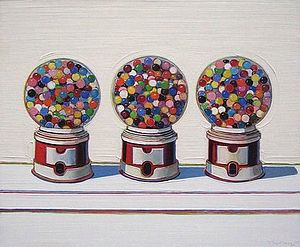2 Class Periods
 |
| Three Machines, First Grade Art Lesson |
Wayne Thiebaud was born in 1920, in Mesa Arizona. He began his art career as a cartoonist working for Walt Disney. He later, became an art teacher and taught students for nearly 20 years.
 |
| Artist Wayne Thiebaud |
 |
| Cakes by Wayne Thiebaud. |
The piece that we used for our inspiration is called the Three Machines.
 |
| Three Machines by Wayne Thiebaud. |
Day 1:
- Students learned about the life and artwork of Wayne Thiebaud.
- As a class we discussed complementary color schemes (red and green, blue and orange, yellow and violet). Each student had to choose the complementary color scheme they wanted to use for this assignment.
- Together we constructed the machine parts through follow along demonstration.
- Pieces were glued onto the paper. The placement of the machines and the use of space within the composition was discussed.
Day 2:
- The three characteristics of Wayne Thiebaud's artwork were reviewed.
- Students were asked to incorporate shadows within the composition by using color crayons in the complementary color scheme they selected the class period before.
- Students were given the remainder of the hour to incorporate, cut, and glue "gumball" pieces out of construction paper for each machine.
Examples of Student Work:














































